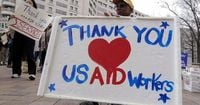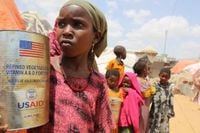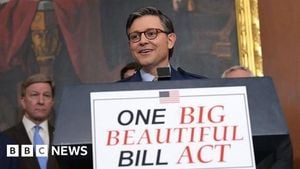On July 1, 2025, the United States Agency for International Development (USAID), a cornerstone of American foreign aid for over six decades, officially ceased to exist as an independent agency. Founded in 1961 by President John F. Kennedy to wield aid as a strategic tool during the Cold War, USAID has been absorbed into the State Department following sweeping cuts that have slashed 85 percent of its programming under the Trump administration, led by Secretary of State Marco Rubio.
The administration has hailed this transition as the end of a "charity-based model," signaling a shift in how the U.S. approaches international aid. However, this move has sparked grave concerns among experts, researchers, and humanitarian workers worldwide, who warn that the dismantling of USAID could have catastrophic consequences on global health and development.
Dr. Brooke Nichols, an associate professor at Boston University and a mathematical modeler specializing in infectious diseases, has been at the forefront of quantifying the human toll of these cuts. In late January 2025, after learning about the Trump administration’s drastic reduction of USAID funding—amounting to a staggering $7.7 billion, or 83 percent of its grants—Nichols began what she calls “back of the envelope” calculations. Her work culminated in the Impact Counter, an online dashboard launched in early February that estimates the number of deaths attributable to these funding cuts.
Focusing on 42 percent of the former USAID budget, Nichols’ estimates reveal a sobering reality: as of June 26, 2025, approximately 332,553 people have died worldwide due to the funding reductions, including 224,575 children. These figures encompass deaths from diseases such as HIV/AIDS, malaria, tuberculosis, pneumonia, and others that USAID programs previously treated or prevented.
Her methodology involves analyzing World Health Organization data on disease incidence and mortality, cross-referencing these with the average cost of treatment and USAID’s budget allocations. This approach allows her to estimate the number of patients losing access to treatment and, consequently, the number of preventable deaths. Nichols, who spent three years in South Africa analyzing HIV testing strategies for local governments, draws on her extensive experience in the field to inform her calculations.
Yet, the impact of USAID’s closure extends beyond immediate mortality. For example, Nichols estimates that in 2025 alone, around 1.12 million malnourished children will go without food due to cuts to the agency’s $168 million nutrition budget. This figure aligns with estimates from Nicholas Enrich, acting assistant administrator for global health at USAID, underscoring the severity of the crisis.
These grim statistics are echoed in a comprehensive study published on June 30, 2025, in the medical journal The Lancet. Conducted by a 15-member international research team from Spain, Brazil, Mozambique, and the U.S., the study projects that more than 14 million additional people could die by 2030 as a direct consequence of USAID’s funding cuts. Among these, 4.5 million children under the age of five are expected to succumb to preventable diseases and malnutrition.
Despite these alarming projections, Secretary of State Marco Rubio has publicly disputed the claims. In congressional testimony, Rubio challenged Nichols’ figures, arguing that they assume a near-total freeze of U.S. foreign aid, which he says is inaccurate. “I think it’s exaggerated,” Rubio stated, emphasizing that about 14 percent of USAID programs remain funded, including 31 percent of HIV funding, 28 percent for tuberculosis, and 32 percent for malaria, according to a recent New York Times report.
Rubio further argued that if hundreds of thousands of children had died in recent months due to funding cuts, it would imply that no other global actors were stepping in to provide aid. “We’re taking care of the entire planet?” he questioned skeptically. However, Nichols counters that her Impact Counter dashboard accounts for partial funding cuts and, after updating her estimates with more precise data, the death toll figure was only reduced by 12.5 percent. She insists that the numbers remain deeply concerning.
Adding to the debate, Elon Musk, who departed from the Department of Government Efficiency in May 2025, took to X (formerly Twitter) to assert that “zero people have died” due to the cuts. Musk claimed that only 10 percent of USAID’s funds directly supported patient treatment, implying that the impact of the cuts was minimal. However, this view has been met with skepticism by public health experts and USAID supporters, who acknowledge inefficiencies in the agency’s $35 billion budget, particularly due to Washington-based contractors, but argue that these do not negate the essential life-saving work USAID performed.
Dr. Cassidy Claassen, a physician affiliated with the University of Maryland’s medical school and actively involved in HIV prevention in Zambia, believes Nichols’ estimates are conservative and likely understate the true impact. “She’s taken a very conservative approach, and her estimates give us a minimum number that we can be almost sure of,” Claassen said. She notes that Nichols’ model does not include diseases like polio, which could worsen due to disrupted vaccination programs and varying herd immunity across countries.
Claassen, alongside Linah Mwango, technical director of the Center for International Health, Education and Biosecurity (CIHEB) in Zambia, manages HIV/AIDS programs that historically relied heavily on PEPFAR funding, a major component of USAID’s portfolio. Approximately 60 percent of their HIV program funding came from PEPFAR, with the remainder from NIH grants. While treatment funding has largely been preserved, community prevention and awareness initiatives have been halted, allowing HIV to spread unchecked in vulnerable populations.
Particularly affected are marginalized groups such as female sex workers, people who inject drugs, men who have sex with men, transgender individuals, and incarcerated populations. According to Claassen, these groups’ programs were deemed “inappropriate” by the Trump administration, effectively cutting off critical support. Mwango highlighted that in Zambia, the government lacks the resources to compensate for lost funding, especially for early interventions proven to control HIV transmission effectively.
Because the average time from HIV infection to death spans eight to ten years, Mwango suggests that mortality impacts may not become evident for two to three years, but nutritional deficiencies and other immediate health consequences are already measurable. This timeline underscores the long-term ramifications of USAID’s dismantling.
Similarly, in South Africa, Dr. Kate Rees of the Anova Health Institute warns that the cuts will precipitate a prolonged crisis. Anova previously benefited from USAID grants targeting HIV control nationwide. “Governments are scrambling to try and fill the gaps,” Rees said, “but with no notice, that’s incredibly difficult.”
As USAID’s programs transition under the State Department’s umbrella, the official stance is that critical humanitarian aid aligned with U.S. foreign policy priorities will continue. However, many fear that the scale and scope of aid will never match what USAID once provided, particularly in addressing the nuanced needs of vulnerable populations and combating diseases that require sustained, targeted interventions.
The closure of USAID marks a profound shift in U.S. foreign aid policy, with consequences that experts warn will echo for years, if not decades, to come. The debate over the human cost of these cuts remains heated, but the mounting evidence points to a sobering truth: millions of lives hang in the balance as the world adjusts to the new reality of diminished American aid.





